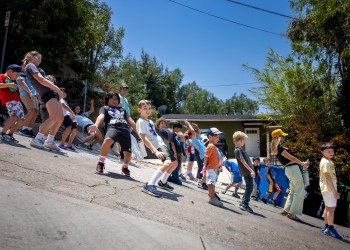Many of America’s worst traffic bottlenecks are holding up commuters for hours each week even where there’s plenty of mass transit nearby.
That’s the upshot of a new report titled “Unclogging America’s Arteries,” which offers a few nostrums that don’t really figure to solve the problem anytime soon.
The most prominent conclusion of the study is that 11 of the nation’s 16 worst bottlenecks are in California, the vast majority in Los Angeles and Orange counties. That won’t surprise commuters accustomed to putting up with parking-lot scenes on I-405, U.S. 101, I-110 and I-10 in L.A., but it might surprise San Francisco drivers to learn that the 1.9-mile stretch of I-80 approaching the Bay Bridge from the south and west wastes more time for more people than all but 11 others nationwide.
It may be more surprising to learn that crowding and delays on I-405 in Orange County are far worse than in New York’s Lincoln Tunnel, costing drivers and their passengers 7.1 million hours of waiting time yearly, more than double what Manhattan and New Jersey folk spend hung up in the always-jammed tunnel system under the Hudson River.
Similarly, it will probably stun the tens of thousands who commute daily on Houston’s Katy Freeway, I-10’s Texas iteration, to learn they’re not even in the top 50 when it comes to wasting time. That almost has to be an error of omission.
One remarkable thing about all this is that more than a dozen routes listed among the nation’s most crowded (a stretch of Chicago’s I-90 ranks No. 1) run near and parallel to mass transit. Theoretically, then, it’s possible to bypass the frustrating waits by riding trains or busways.
Thus, many commuters frustrated by Bottleneck #7, the Ventura Freeway in the San Fernando Valley portion of Los Angeles, could be riding the Metro Orange Line nearby instead, but don’t.
The same for drivers tied up on I-110 near downtown Los Angeles, who could be on the Metro Gold or Blue lines. Or plenty of drivers on that often-congested stretch of skyway in San Francisco, many of whom could ride BART.
One lesson here, then, is that mass transit doesn’t solve all congestion. Just look at the I-10 between downtown Los Angeles and the city’s Westside, where commuters sit and wait while trains zip unmolested along the almost parallel, mostly completed Metro Expo Line.
Altogether, California drivers last year wasted more than 47 million waking hours waiting in traffic along the state’s 15 most congested routes.
The federal planners who put out the new report appear to have few viable ideas for getting stalled traffic moving. They call for “cost-effective, high-impact” investments to improve traffic, but quickly add that “There is no silver bullet for addressing it.”
Among their low-cost suggestions are expansion of the 511 telephone traveler information system, and offering advisories that suggest alternate routes via radio stations and message signs. All those techniques already exist on many of the super-crowded California stretches, but they have not gotten traffic moving.
The planners also suggest using smartphone apps like Waze that let drivers reroute around the worst jams. Those apps have been known to infuriate residents in once-quiet neighborhoods that now see heavy traffic sent their way by the robotic voices of modern cellphones.
More managed lanes, like the toll lanes already used on some of California’s (former) freeways are another recommendation.
But the bottom line solution appears to be both simpler and more complex than anything traffic authorities and their planners can do: To move faster, drivers will have to start leaving their cars behind in mass transit parking lots and letting train operators do the driving.
As long as the vast majority of motorists are unwilling to do that, bottlenecks will be the rule, not the exception in the most populous, most congested parts of California.


























